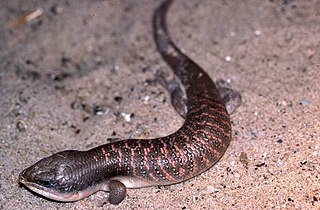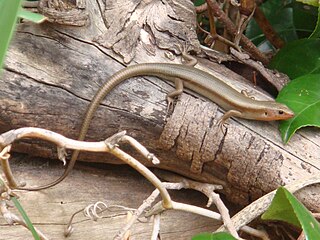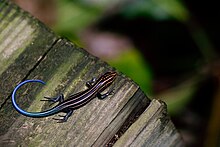
The genus Eumeces comprises four African to Middle-Eastern skink species.
Feylinia is a genus of skinks. It is usually placed in the monotypic subfamily Feylininae.

Mesoscincus is a genus of lizards, comprising three species of skinks native to Mexico and Central America. The species were formerly included in the genus Eumeces.

The western skink is a species of small, smooth-scaled lizard with relatively small limbs. It measures about 100 to 210 mm in total length. It is one of seven species of lizards in Canada. They spend much of their day basking in the sun. Their diet ranges widely, including spiders and beetles. Western skinks will bite if grasped and will flee if they feel threatened. It is a common but secretive species whose range extends from southern British Columbia and throughout Washington, Oregon, Nevada, Utah, Idaho, and Wyoming and into western Montana and northern Arizona and Missouri. They can also live in some areas of Texas It is widespread in northern California but primarily restricted to the coast in central and southern California. Found in a variety of habitats, this lizard is most common in early successional stages or open areas of late successional stages. Heavy brush and densely forested areas are generally avoided. Western skinks are found from sea level to at least 2,130 m (7,000 ft). This diurnal reptile is active during the warm seasons.

The broad-headed skink or broadhead skink is species of lizard, endemic to the southeastern United States. The broadhead skink occurs in sympatry with the five-lined skink and Southeastern five-lined skink in forest of the Southeastern United States. All three species are phenotypically similar throughout much of their development and were considered a single species prior to the mid-1930s.

Plestiodon gilberti, commonly known as Gilbert's skink, is a species of heavy-bodied medium-sized lizard in the family Scincidae. The species is endemic to the southwestern United States and northwestern Mexico, and grows to about 7 to 12 cm in total length.

Eumeces schneiderii, commonly known as Schneider's skink, is a species of lizard in the family Scincidae. The species is endemic to Central Asia, Western Asia, and North Africa. There are five recognized subspecies.
Eurylepis poonaensis, the Poona skink, is a species of skink found only in Maharashtra, India.

Eurylepis taeniolata, the ribbon-sided skink, alpine Punjab skink, or yellow-bellied mole skink, is a species of skink found in Central Asia, South Asia, and West Asia. It is the type species of the genus Eurylepis.

Eumeces algeriensis, commonly called the Algerian skink, Algerian orange-tailed skink, Berber's skink, in French eumece d'Algérie, or in Spanish bulán, is a species of skink in the family Scincidae. The species is endemic to the Maghreb region of North Africa.

Scincinae is a subfamily of lizards. The subfamily contains 33 genera, and the genera contain a combined total of 284 species, commonly called skinks. The systematics is at times controversial. The group is probably paraphyletic. It is one of three subfamilies of the family Scincidae, the other two being Acontinae and Lygosominae.
The Tepalcatepec skink is a species of lizard in the family Scincidae. The species is endemic to Mexico.

Plestiodon barbouri, also known commonly as Barbour's blue-tailed skink and Barbour's eyelid skink, is a species of lizard in the family Scincidae. The species is endemic to the Ryukyu Islands (Japan).
Plestiodon copei, also known commonly as Cope's skink, is a species of lizard in the family Scincidae. The species is endemic to Mexico.

Plestiodon dicei, or Dice's short-nosed skink, is a species of lizard which is endemic to Mexico. It was named in honor of Lee R. Dice, who collected the holotype in 1930 while conducting a faunal survey in the Sierra de San Carlos, Tamaulipas, Mexico. It was considered a subspecies of Plestiodon brevirostris for many decades. Plestiodon dicei occurs in northeastern Mexico, in the Sierra Madre Oriental in Coahuila, Nuevo Leon, San Luis Potosi, and Tamaulipas, with isolated populations in the Sierra de San Carlos and the Sierra de Tamaulipas.

Plestiodon dugesii, also known commonly as Dugès' skink, Duges's skink, and eslabon in Mexican Spanish, is a species of lizard in the family Scincidae. The species is endemic to Mexico.

Plestiodon japonicus is a species of lizard which is endemic to Japan. The IUCN lists the species as least concern.

The Okada's five-lined skink or Far Eastern skink is a species of lizard which is endemic to Japan.

Plestiodon lynxe, also known commonly as the oak forest skink, is a species of lizard in the family Scincidae. The species is endemic to Mexico. There are three recognized subspecies.
Plestiodon longiartus is a species of skink which is endemic to Mexico.














